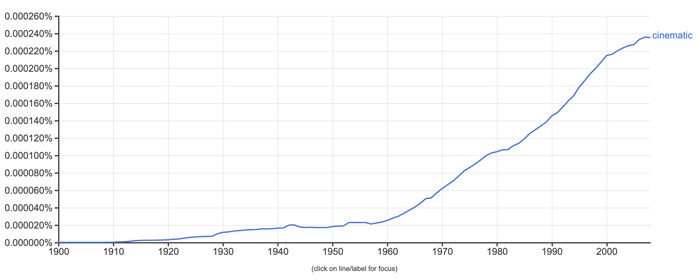What is “Cinematic”? Cinematographers answer
Cinematic is a word that has steadily increased in usage over the last 100 years. Well, that’s no surprise really, as it matches the invention of the medium over a century ago. But since the digital age, and specifically video sharing platforms such as YouTube appeared, it seems the word has taken on a new meaning.

The Golden Age of Hollywood is considered to be from 1917 to 1960. So it’s interesting then that, looking at the graph above, the word “cinematic” doesn’t take off in usage until exactly after that point.
Google gets this statistic from analysing books published over the time set. So we can see that people writing about the term cinematic took off in the 1960s and kept going.
Cinematic in the Internet Age
YouTube now hosts a large number of videos promising to give you essential knowledge enabling you to make your own videos “cinematic”. Presumably, many of the filmmakers searching for this knowhow intend to upload their videos to YouTube, Facebook, Vimeo or other web platforms. And surely these platforms are what one might consider the very antithesis of cinema: tiny screens with an audience of one.
Therefore, the word cinematic is changing. Well, words change as society changes, that’s what makes a healthy language. So what does it mean now?
I interpret it to mean: somewhat saturated colours, clear images (as high resolution as possible), blurry backgrounds (shallow depth of focus), smooth stabilized shots, lens flares, wide screen format and that kind of thing.
What do working cinematographers think?
It’s a couple of years old now but in this video from Cooke Optics they asked professional cinematographers to define “cinematic”.
The first thing that interests me is that after 2 years this video has just over 60,000 views. While other explanations of how to make your video cinematic can have millions of views. So far more people on YouTube are learning how to make their film “cinematic” from people who have never shot a film screened in a cinema, than from those who have.
Laurie Rose (High-Rise, Sightseers, Kill List, Peaky Blinders) says productions for cinema and TV now use pretty much the same equipment. But I would say with streaming becoming a dominant force, the line between cinema and TV doesn’t exist any more. The only real difference is format length.
In the video above, none of the cinematographers agree on what makes something cinematic. What’s interesting though, is that all the descriptions they give could describe anything you shoot with a camera. Whether it’s for theatrical distribution or for your Facebook story.
New lands to explore in the moving image adventure
From the graph we can see that as cinema’s power has faded (as it has to share the moving image space with more and more platforms), the more we are talking about the essence of it.
By the way, the image I used for the headline is not from a film at all. I found it in an article on the website that carries the name of legendary film critic Roger Ebert. Roger is sadly no longer with us, but his spirit lives on. And here we find new, young enthusiasts of the cinematic image – except in this case they’re talking about video games.
Perhaps then cinema – as in theatrical cinema – was the launching pad. We can see it more as a starting point for all art involving the moving image, than as a definable art form limited to the experience of watching a film on a big screen along with an audience.
The branches of that cinema tree spread out to include TV, music videos, YouTube, Facebook, Instagram, video games, VR and who knows what else awaits us in the future. Cinematic is simply the magic essence of something we once saw in a cinema. But there may come a time when 99% of us experiencing something cinematic will have never set foot in an actual cinema.
Eager to learn more?
Join our weekly newsletter featuring inspiring stories, no-budget filmmaking tips and comprehensive equipment reviews to help you turn your film projects into reality!
Simon Horrocks
Simon Horrocks is a screenwriter & filmmaker. His debut feature THIRD CONTACT was shot on a consumer camcorder and premiered at the BFI IMAX in 2013. His shot-on-smartphones sci-fi series SILENT EYE featured on Amazon Prime. He now runs a popular Patreon page which offers online courses for beginners, customised tips and more: www.patreon.com/SilentEye

